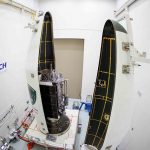UPDATE: According to SpaceX, the launch has been pushed back a second time. Initially the company had not selected a new launch date, but on Dec. 20 they stated that the new date was to be Dec. 22.
Here are some details from the SpaceX website published on Dec. 20:
SpaceX is now targeting December 22nd for launch of the United States Air Force’s first Global Positioning System III space vehicle (SV) from Space Launch Complex 40 (SLC-40) at Cape Canaveral Air Force Station, Florida. Weather is 80% favorable for the launch window which opens at 8:55 a.m. EST, 13:55 UTC.
For this mission, the satellite will be deployed to medium Earth orbit approximately 1 hour and 56 minutes after liftoff. Due to mission requirements, SpaceX will not attempt to land Falcon 9’s first stage after launch. You can watch the live launch webcast, starting about 15 minutes before liftoff.
Here is what the SpaceX website published on Dec. 19:
GPS III SV01 MISSION
SpaceX is standing down from today’s launch attempt of the United States Air Force’s first Global Positioning System III space vehicle (SV) from Space Launch Complex 40 (SLC-40) at Cape Canaveral Air Force Station, Florida to further evaluate an out of out of family reading on first stage sensors. A new launch date will be confirmed once this evaluation is complete,
Below is the original article posted on the Inside GNSS website.
CAPE CANAVERAL AIR FORCE STATION, Fla. — The Air Force’s first Lockheed Martin-built GPS III satellite was encapsulated within a SpaceX payload fairing at Astrotech on Dec. 7 in preparation for its upcoming launch — now scheduled for tomorrow — at Cape Canaveral Air Force Station, Florida.
According to a Twitter post from SpaceX, the launch which was originally scheduled for Tuesday, was pushed back until tomorrow morning. The post on Twitter today reads: “SpaceX team called a hold due to an out of family reading on first stage sensors. Vehicle and payload remain healthy; next launch attempt is tomorrow at 9:07 EST, 14:07 UTC.”
Encapsulation of the satellite within its payload fairing serves to protect it against the impact of dynamic pressure and aerodynamic heating during its harrowing journey through the earth’s atmosphere, and supports the ability to communicate with the satellite until separation from the launch vehicle on-orbit.
GPS III SV01, known as “Vespucci,” in honor of Amerigo Vespucci, the Italian explorer for whom the Americas were named, is now ready to be rolled out to its pad at Space Launch Complex-40, where it will be mated with a SpaceX Falcon 9 rocket.
The launch can be viewed on a SpaceX webcast at https://www.spacex.com/webcast.
Vespucci will augment the current 31-satellite constellation to continue to provide the “gold standard” in positioning, navigation, and timing services for more than four billion users worldwide.
GPS III will deliver capability aligned with the Space and Missile Systems Center’s SMC 2.0 initiative which focuses on innovation to deliver capability to the warfighter.
As the U.S. enters a new era with the declaration of space as a warfighting domain, SMC is re-architecting efforts which will manage other significant U.S. acquisition agility initiatives in order to drive innovation within the space enterprise and speed the delivery of new capabilities to warfighters.
Air Force Space Command’s Space and Missile Systems Center, located at Los Angeles Air Force Base in El Segundo, California, is the U.S. Air Force’s center of excellence for acquiring and developing military space systems. Its portfolio includes the Global Positioning System, military satellite communications, defense meteorological satellites, space launch, range systems, satellite control networks, space-based infrared systems, and space situational awareness capabilities.





